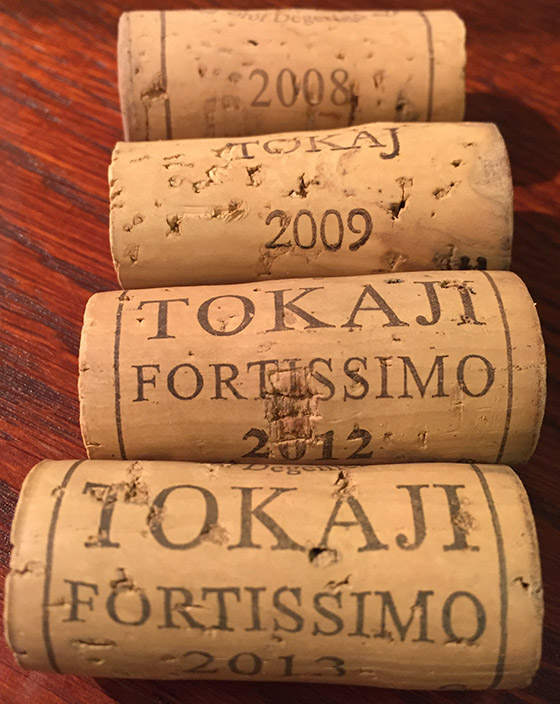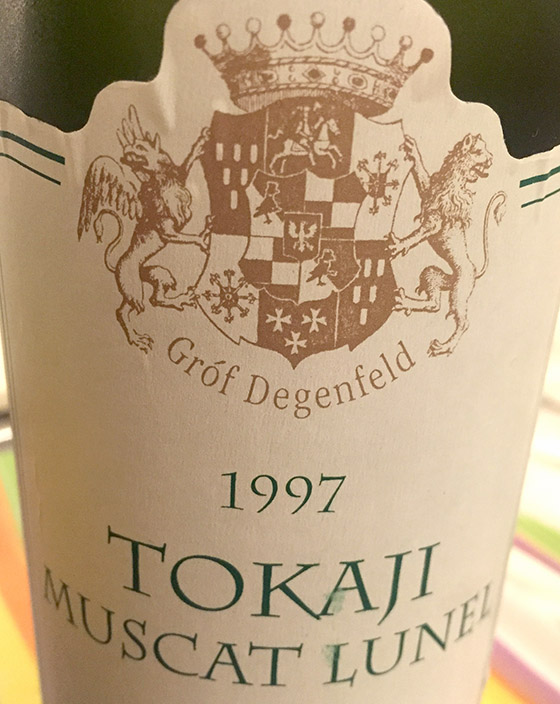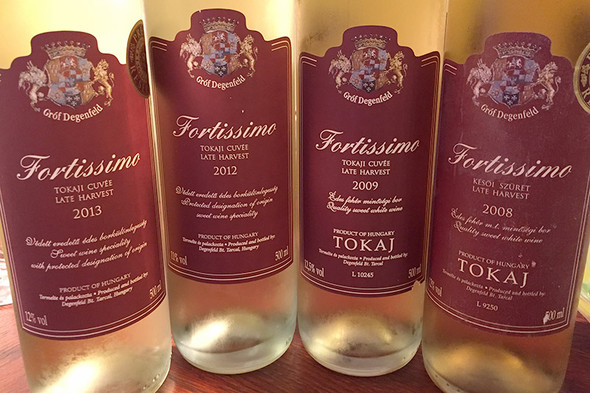Today Tokaj is characterized by its big sweet wine – aszú, obviously – and the “big dry wine” has also appeared – whatever this means. The fact, however, remains that besides the wonderful and elegant hárslevelű wines as well as the lean and sometimes flinty furmint wines, extremely little is said about the third grape variety: yellow Muscat and the late harvest category which is practically invisible behind aszú and szamorodni wines.
Being properly informed about the world wine market, the first point, i.e. neglecting the yellow Muscat, is not only inconceivable but also almost inexcusable. True enough, yellow Muscat is grown in a much smaller area than furmint or hárslevelű, still there is no sign that this would change in any way in the decades to come. Nonetheless, a light, scented dry or maximum semi-dry yellow Muscat wine with low alcohol content and nice acids, closed with nothing but a screw cap could be “the rosé of Tokaj”, the ideal cash-flow wine to be consumed within two years; the wine that is not too expensive but in return would supply wineries with the working capital needed for great wines, especially aszú.
Late harvest is a more serious issue but its role could be reassessed in the light of recent legislative changes. As long as the broad range of aszú wines existed, there was no point in making a separate late harvest wine. No wonder, it only happened when the grapes left outside for aszú, instead of the noble rot, started to shrink due to the unpredictable weather. Now, however, that the minimum sugar content of aszú wines is determined and only those with high (5-6) puttony (hod) number can remain, either sweet szamorodni or late harvest could have a chance that must not be missed. Both have their pros and cons but this part of the range definitely needs sorting out. If aszú is a naturally sweet wine with high sugar content, harmonious balance and made in the presence of botrytis, szamorodni could be its lower sugar-content version. Currently this is not the case though: szamorodni wines bottled with a sugar content of 120–160g/l are not hard to find on store shelves. If the sugar content of szamorodni wines could be maximized at 60 g/l that would open a door to a late harvest wine with 80–100 g/l sugar on condition that these wines can only be produced without botrytis. Naturally, this is only being clever about wines from the sofa, but what else is a winesofa good for?
Gróf Degenfeld has eight Muscat and four late harvest wines in store for us from a total of nine vintages. I would say that their late harvest called “Fortissimo” is still lost a bit; its acids sometimes fail to meet the expectations of winelovers experienced in aszú wines. Nevertheless, it is clear that market-wise (especially in certain international niche markets) this style is ab ovo a definite success story. As for Muscat, we were in for some real surprise. It is already exciting that the oldest item was made in 1997 and the youngest one in 2015, and that each and every one of them are semi-dry. This reveals that Degenfeld realized the market potential of this variety relatively early and has stuck to its original idea without any hesitation. The other surprise – I swear I did not want to spoil the fun, but I simply cannot help it – is the current state of the 1999 Muscat. Read the tasting notes and do not forget: these wines were meant to be consumed within one or two years.

Fortissimo LH 2013 (12%) I 87-89 points
Aromas of mandarin, grapefruit, lychee, white pepper and a touch of soy in the background. Well-proportioned on the palate with rounded acidity, ripe white-fleshed fruit, plenty of peach and a little honey. Very drinkable, with the citrus notes echoed on the long finish (according to my wife, rather like a gentlewoman, a little sweet, but not over the top).
Fortissimo LH 2012 (11%) I 85-87 points
Aromas of mint, peach and candied fruit. Medium bodied on the palate with rounded acidity. Flavours of peach, lychee, pear and white flowers. Medium finish. A very drinkable wine, a real gastronomic all-rounder!
Fortissimo LH 2009 (12.5%) I 83-85 points
Beautiful maturity on the nose, with mandarin, orange zest, a little tea and marshmallow. Medium to full-bodied on the palate; due to its soft acidity, the wine seems a little sluggish. Flavours of overripe white-fleshed fruit, peach, pear and a little apple. The finish displays a slightly oxidised note in the guise of some grated apple.
Fortissimo LH 2008 (12%) I 86-88 points
Deep golden colour. Aromas of ripe greengage, purple flowers, some honey, candied pineapple and stewed apricot. Full-bodied with rounded acidity and flavours of citrus fruit, mandarin, pineapple, orange zest, a touch of clove and some tea. Unfortunately, only medium on the finish, although very complete and extremely drinkable.
Muscat Blanc semidry 2015 (11.5%, new Tokaj bottle, screw cap) I 82-84 points
Very fresh nose of citrus, gooseberry and herbs. Light and taut on the palate, with vibrant acidity plenty of citrus fruit, lemon, lime and a chalky mineral background. The residual sugar is also offset by the acidity, making the wine feel bone dry.
Muscat Blanc semidry 2013 (11.5%, screw cap) I 86-88 points
Some brown liquid and sand-like material under the screw cap. Pale lemon in colour. Aromas typical to Muscat, white flowers, a little gooseberry, citrus fruit, reminiscent of a New World Sauvignon Blanc. Light on the palate with rounded acidity, a very drinkable wine, with the sugar only detectable underneath. Flavours of ripe apple, gooseberry and pear, with white pepper and white flowers in the background. Medium finish; a perfect gastronomic wine or a summer hit, well chilled in the heat!
Muscat Blanc semidry 2012 (12%, screw cap) I 79-81 points
Flawless closure. Pale lemon in colour. Aromas of ripe white-fleshed fruit, apple, pear, a little peach with some citrus fruit in the background. Medium body, a bit flabby acidity, the palate reflects the nose with flavours of white-fleshed fruit. Slightly flat and a rather short finish too. If you have some at home, you should drink it now, as I don’t think it will improve.

Muscat Lunel semidry 2010 (12.5%) I 78-80 points
Beautifully mature on the nose with Mediterranean citrus fruit, some butter, corn, thyme and mint. Medium bodied with flabby acidity, making the whole wine seem a lazy. Flavours of ripe mandarin apple and pineapple. Short finish.
Muscat Lunel semidry 2009 (12.5%) I 72-74 points
On the nose, plenty of cloyingly sweet flowers, grated apple and biscuit. Medium bodied with rounded acidity, but unfortunately the palate is clearly oxidised. What a shame.
Muscat Lunel (semidry?) 2003 I 82-84 points
Pale lemon in colour. On the nose, apple, pear, white flowers and a little soap. Medium bodied with rounded acidity and flavours of birthwort, green apple, peach and an increasingly bitter taste. Unfortunately, the finish is rather short.
Muscat Lunel semidry 1999 (11%) I 83-85 points
Golden colour. Aromas of honey, mandarin, pineapple and orange with Mediterranean herbs and a hint of vanilla in the background. Medium bodied with rounded acidity and flavours of ripe citrus fruit and honey, with a touch of vanilla appearing in the background. Medium to long finish with attractive bitterness and brittle lingering. The wine is in really lovely condition, a real surprise!
Muscat Lunel semidry 1997 (12%) I 77-79 points
Incredibly intense nose with plenty of overripe pear and Williams pear. Medium bodied with silky acidity. The pear flavours also dominate the palate but the residual sugar definitely makes itself felt too. Indeed, the balance is tipped a little towards the sugar, clearly due to the lack of acidity.






